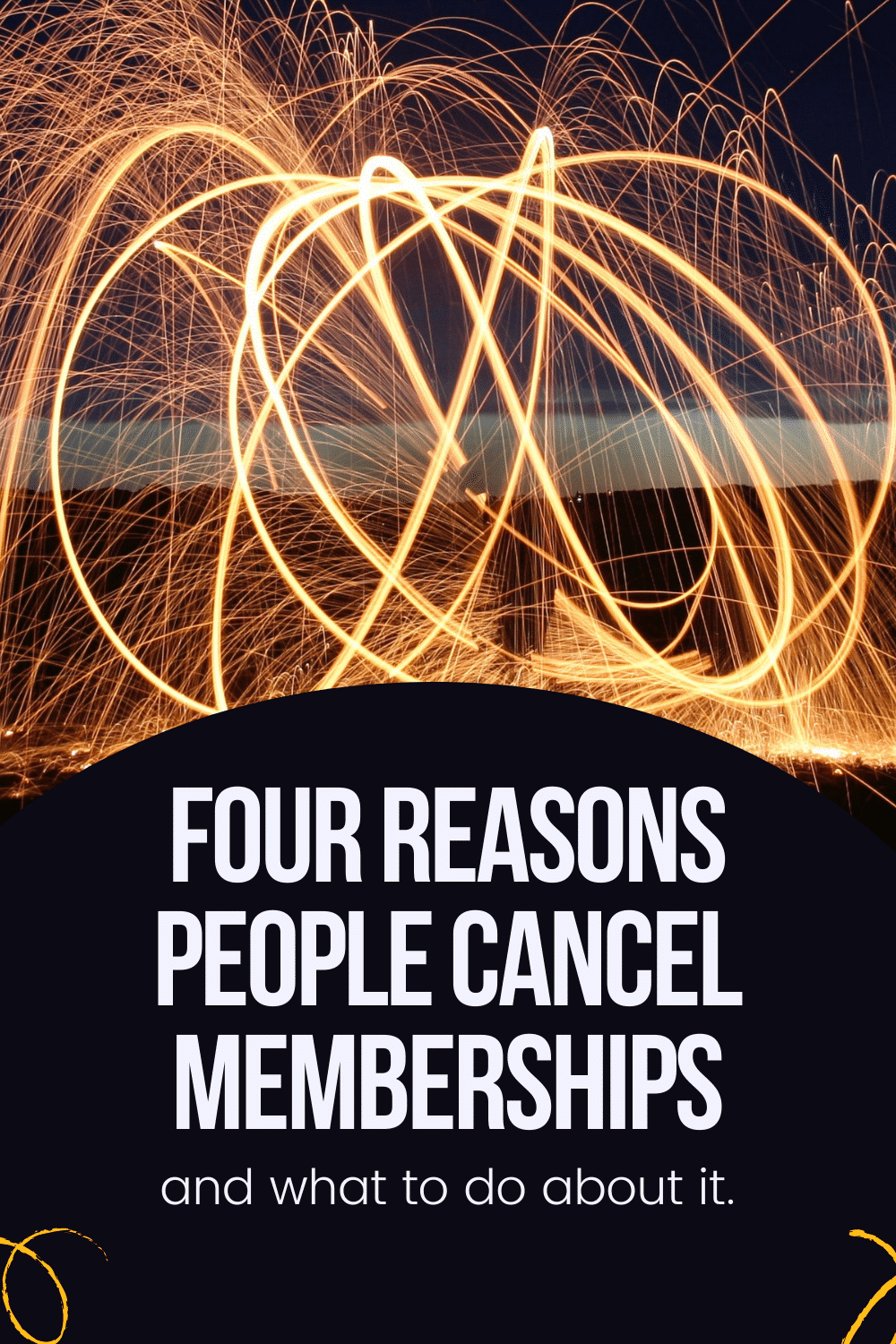Let’s be honest, the first time that you ever got a cancellation subscription notice, you probably felt a little cold stab in the gut. I know I did.
Nine times out of 10, when somebody’s canceling their membership it has nothing to do with you personally. It is a learning opportunity that you can take advantage of.
Your attrition rate, the rate of how often people cancel their memberships (this is usually expressed as a percentage) is an important metric for your community health, but unless you have some idea about why people are leaving, it’s difficult to make the appropriate changes.
Don’t know your attrition rate? Use this formula:
((ME-MN)/MS) x 100
The formula to determine your community attrition rate
Let’s break down the formula a bit for those of us who haven’t taken a math class in a while.
ME = Members at the end of a specific time period
MN = New members added during that same period
MS = Starting Members at the beginning of the time period
Industry attrition rates can vary, but if you have an online community & your attrition rate is over 3% it’s time to take massive action. Anything less than 1% is something to be proud of.
Listen to this Session, or keep reading…
Reason #1: Change in Financial Situation
Let’s just come right out and say it, they had a financial situation change. Things change. Money changes, priority changes, focus, careers, business cards, expiration dates; there’s a lot of reasons why someone’s financial situation would caused them to cancel their membership.
The truth is, they might not have even wanted to cancel their membership. If it’s a financial situation change, they might have been having to make hard choices in the process.
And yet you’ll never know unless you ask, but how do you ask.
Here’s the first thing you need to put into action, immediately:
Create an exit survey so that you can get the real perspective, on what people think as they’re leaving your membership.
If you don’t ask, you’re not going to learn. It can be a little bit bruising to the ego, if it’s feedback that you don’t want to hear, but the truth is knowing is better than not knowing.
Let’s say it’s a member that’s been around for a while, and you’re actually surprised when you see their cancellation come through.
I like to implement a philosophy called
“Keeping the Door Open”.
That person may want to come back in the future. I want to keep the door open for them. If that person was a value to me in my community. I want to make sure that the door is as wide open as possible for them to come back, if it’s all well and good in the future.
So, when you get your exit survey results back, and you figure out why somebody really left and they tell you that it was something far more personal and wasn’t their first choice; isn’t it an emotionally intelligent and warm thing to say, “Well, I want to let you know that you are of value to this community, and if you ever want to come back – by the end of the year, or in six months, or whatever timeline feels appropriate for you – you can come back at your original subscribed rate because you’re a value to me and I want you in my community.”
When you’re saying that, you’re reiterating to your community member that they’re more than just a dollar sign to you. That’s so incredibly important when you’re trying to keep the door open.
Even if they never take advantage of this door returned policy, this sets you up to have the door open for them in a referral capacity, in a friendship capacity, in a warm thoughts and manner type way. Right?
It’s super important that we have that conversation with them where we find out exactly what’s going on, and then convey to them that they’re important and that you want to keep the door open for them.
Reason #2: Overwhelm
Listen, some of you are doing a little bit too much. That’s like, that’s it. It’s just too much.
When we’re creating a new program, we can really want to over-deliver on the value, and we pull absolutely everything we have (and the kitchen sink) into our program or into our membership or into our content.
What we don’t realize is that the average person who is consuming our content and consuming our products, can only handle – max – 60 to 90 minutes of new content a week.
I know. Only 60 to 90 minutes of new content a week.
And if you were kind to them, and you really wanted them to make progress, you would keep it into small little bite-sized bursts that they could, not only consume, but take action on, in under 90 minutes a week.
(Personal note: I am guilty of this more than most, because in my regular life, I am a bit of a knowledge junkie. And I assume that everybody wants to learn, all at once, bingeing over a weekend, the way that I like to do it. But that’s just not true.)
You’ll probably see people like this in different groups where they’re quickly getting overwhelmed by the new content and new idea because it’s coming at them so quickly, they don’t have a chance to absorb it.
There’s also the level of overwhelm where somebody jumps in, learns a whole lot, realizes it’s going to take a long time for them to actually put it into action.
“I just listened to five hours of content, but now I realize it’s going to take me six months to implement this.
Why would I keep paying for six months?”
So, what is the solution to overwhelm?
First it starts with having a robust and personalized (emphasis on the word personalized) onboarding process.
This is an entry assessment. “Where are you in your life business, et cetera. Why are you here? What is your core goal along the Community Success Journey? Where are you? And what content is ideal for you to start with?”
When you do that, you can direct them just like the hostess at a party.
When somebody comes to the door, you say, “oh my god, welcome on my house. You can put your coat over there, the bathrooms behind here’s where the drinks are, have you met Johnny? He’s doing the same thing that you’re doing. The first thing you’re going to want to do is grab one of those mimosas over there and then head out to the back deck. It’s so beautiful. You’re gonna love it.”
That experience alone can be done in a thoughtful entrance assessment, automatically directs them to an appropriate place in your content where there’s a pre-recorded video and a selection of things to accomplish.
But what it does for the lifetime value of your membership? It triples it.
Maybe, they were going to be members for a year at a thousand dollars. Now they’re going to be part of your ecosystem for three years.
Why? Because onboarding and that personalized experience, soothes the psychological part of us that is worried that we’re not going to get our money’s worth when we sign up for a subscription. It’s the opposite of the part of our brain as program creators that says “I’m creating a subscription, I want to make sure they get their money out of it.”
The solution is not more content.
The solution is more context.
Get the context of why they’re there, get the context of what it is they’re trying to accomplish, and give them the context of where to start and accomplish things. You will see your “overwhelmed subscriptions” reduce. People won’t have the opportunity to be getting overwhelmed.
They’ll be escorted sweetly into the party.
Reason #3: Never Used It
The third reason that people might be unsubscribing from your membership is that they never used it. Maybe it was an impulse purchase. Maybe it wasn’t what they expected. For whatever reason they forgot, they even had it until they saw the recurring transaction on a statement somewhere.
While this situation is not ideal, it’s not unredeemable.
This is advanced community monitoring, in the context of data and understanding what’s going on. When you take a look at the metric of “who purchased and stopped engaging after the first two weeks” and “how can I reach them, and bring them back into the fold?”, this is where you can begin creating warm up sequences and second chances to appropriately onboard and reignite that relationship. Bring them back in and give them the value that your community promises without waiting until they cancel their subscription to do so.
This keeps them from getting to the point at which they canceled their subscription for never using it in the first place.
Reason #4: They didn’t need it or outgrew it
The fourth and final reason that people might be canceling their membership subscription with you is that they didn’t need it, or they outgrew it, or they decided to do it by themselves.
Again, maybe this was an impulse purchase, maybe they didn’t, get what they expected, or they got clarity about a bigger need that they needed to resolve first.
For example, people who want to create communities often realize that they need to create a stronger email list before they launch a bigger community or a bigger program. So, they’ll put down the community program, and go and find a list building program, until they’re ready to come back to it. Right? For whatever reason, they didn’t need it, they outgrew it or they decided to do something different.
The truth is it’s back to the same statement, “you’ll never really know if you don’t ask.”
This is where it’s incredibly important to have exit interviews as well as member assessments.
When somebody onboards into your program, if you assess where they are, you can get an early sense of where to direct them so they get the maximum amount of results.
In the exit interview, this is for you to learn if your messaging isn’t matching up with the promise, or the content inside the community. This is where you can get unfettered feedback about the quality of your community- if you lean into it.
You need to learn more about why they didn’t need it or how they outgrew it, because this will help you understand if the content and the messaging of your program, and the expectations of the people who are buying it, are in alignment.
You won’t know this, unless you have the vulnerable conversation, “Please, tell me why you’re canceling your membership.” When you have this conversation with them, you’ll learn a lot.
This does not mean that you need to jump, and change tack the moment that you get critical feedback from an exit survey.
When leading a community, listen and respond thoughtfully, but continue to lead.
– Starlight
Rather than hurry into action, just because you got one person out of 10, to say that they didn’t need whatever was in your program, is a reactionary choice, and not a strategic one. That is not leading, that’s just reacting.
Please remember that even when you’re accepting feedback, to give it time to sink in.
Ask yourself; what is the best way that I could solve this strategically? Have I been listening and responding thoughtfully? How will I continue to lead this situation to its ideal outcome?
Take Action, Jackson!
- Create an exit survey & make sure it is sent every time someone cancels their subscription
- Create an onboarding assessment and direct new subscribers to the right content for them
- Create a welcome back & 2nd chance email series to reinvigorate subscribers
- Run regular assessments of your attrition rate. (If it gets anywhere over 3% – it’s serious.)





